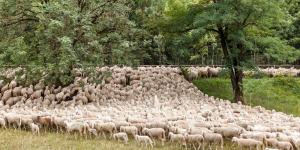What Is Regenerative Farming? - Principles and Examples


Regenerative farming is a sustainable production practice and philosophy which is applied to the agriculture sector. The guiding principles of regenerative agriculture exist to ensure the conservation and regeneration of ecosystems while still exploiting them to create various types of produce. Traditional approaches to agriculture can result in environmental degradation such as soil deterioration, habitat destruction and pollution. Regenerative farming seeks to minimize such degradation and ensure that the land is perpetually fit for use.
At thedailyECO, we learn more about these agricultural practices by asking what is regenerative farming? We look at the principles and examples of regenerative agriculture to see how it can be best employed to produce the products we use everyday.
What is regenerative farming?
Regenerative farming is both an agricultural practice and a philosophical approach to land use. It is used as a tool for sustainable production and it requires a commitment to improving our future. We look at these aspects of regenerative farming in more detail:
- Practice: it is an organic agricultural practice because it aims to improve the traditional form of agriculture in which soils are constantly worn out and exhausted. This proposal attempts to regenerate and build healthy soils.
- Philosophy: it is a philosophy because it includes an ideology that has been formed from various thinkers who promote respect for our environment, for the soil that provides us with food and for agricultural producers who deserve to benefit from environmentally friendly production techniques.
- Tool: it is a tool for sustainable production since it cannot be generated with old production tools that did not take into account the recovery of the soil, nor its nutritional renewal.
- Commitment: it is a commitment because the producers who are generating sustainable crops participate in an exchange of responsibilities with the new generations.
Discover an approach to aquatic farming which uses similar practices in our article on what is aquaculture in agriculture?

Principles of regenerative farming
The main principles of regenerative farming are the following:
- Regenerate the soil: practices are adopted that increase soil fertility, prevent soil erosion and focus on local crops. Discover more about soil erosion and soil care with our article asking what is soil science study?
- Regenerate ecosystems and biodiversity: ecosystems are regenerated in various ways, such as reducing the use of synthetic biochemicals is reduced which harm the environment. The rational use of water, agroforestry and silvopastoral resources is also taken care of. The silvopastoral system is a form of agriculture which integrates various tree systems with livestock to better manage pastures and protect ecosystems. It is a form of agroforestry.
- Regenerate the relationship between living beings: the way in which we relate to other living beings and the nature that surrounds us is reconsidered. It requires paying attention to the dignity of animals by protecting their rights. It does so by using production methods which are both ethical and transparent.
- Regenerate knowledge: promotes the right of agricultural workers to have new knowledge which is oriented to the common good, as well as a respect for natural resources and labor efficiency based on sustainable practices.
Examples of regenerative farming techniques
Among the techniques used to implement the principles of regenerative farming, we can find the following:
- Crop rotation: by always planting the same product, the soil degenerates and loses its nutritional properties. By changing the crop between seasons and sowing plants that enrich the soil, the balance can better be restored. Discover more about crop management with the difference between organic and natural food.
- Reduced soil work: chemical agents limit fertility. Deep plowing, excessive use of agrochemicals , heavy machinery and the elimination of wild plants must be avoided.
- Plant cover: the soil should never be left without plants, which is why it is important to use green manure and respect the growth of wild plants on the land to be cultivated.
- Waste reduction: the circular economy allows there to be no waste in the indiscriminate use of water. Also in the use of natural fertilizer that comes from the waste of livestock production is promoted. So too is the use of surplus production for livestock feed.
- Regenerative Grazing: farmers can improve the health of an organic soil by strategically grazing their livestock.
- Farmer cooperatives: these allow producers to exchange their products or buy and sell at fair prices.
- Financing: ties are created with national and local governments in order to provide support to producers who are changing their regular practices to regenerative ones.
- Education: information forums are created so that producers know the advantages of practicing healthy agriculture for the environment.
Here are some examples of what we can do to start practicing regenerative agriculture:
- Use of mobile pens to organize rabbits and chickens.
- Use of microorganisms for the production of microfertilizers.
- Intensive cow grazing with better programming, agendas and rotation of headquarters.
- Using wood from chipped branches instead of traditional earth humus.
- Use of biochar which allows the soil to retain microorganisms, water and nutrients in general.

Advantages of regenerative farming
Regenerative agriculture would not be good practice if it did not benefit the farmers, the ecosystems used in agriculture and the consumer. In this way, we can say the advantages and benefits of regenerative farming include the following:
- Is sustainable
- Is environmentally friendly
- Is ethical in the treatment of animals and the environment
- Is educational by integrating producers in new knowledge
- Reduces physical, chemical and biological damage to the soil
- Promotes the production of local crops
- Protects microorganisms that live in the earth
- Does not use farming instruments that alter the biodiversity of the soil
- Improves soil structure
- Increases water infiltration
- Reduces erosion
- Reduces water evaporation
- Promotes the biological activity of the soil
- Does not pollute
- Consumes less energy than conventional agriculture
- Produces savings by not consuming chemical products
Now that you know what is regenerative agriculture, as well as its principles and techniques, you may be interested in our related article on the causes and consequences of overfishing.
If you want to read similar articles to What Is Regenerative Farming? - Principles and Examples, we recommend you visit our Ecology (other) category.
- Font Rovira, F., & Madeo Salvá, N. (2013). Regenerative agriculture. Spain: Mundi-Prensa Editions.
- Font Rovira, F. (2021). Rooted in the land: Proposals for regenerative agriculture. Spain: Dandelion Editorial.







